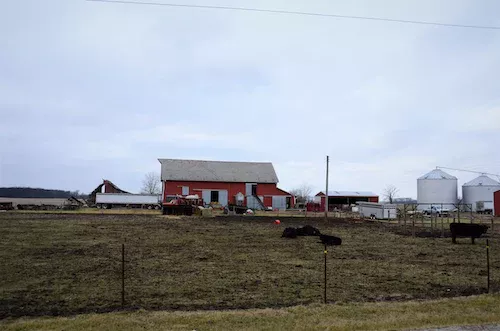9 Agricultural Land Buildings Without Planning Permission
If you're looking to develop agricultural land buildings without planning permission, it's important to understand that it can put a strain on local resources and potentially have negative environmental and social implications. In this article, we'll cover the potential obstacles you may face when developing agricultural land buildings without planning permission.
Building a structure on agricultural land without the need for planning permission is usually for small, low-impact buildings such as agricultural storage units, farm offices, small greenhouses, and livestock shelters. Structures like windbreaks, silos, grain bins, hay storage, and polytunnels are also included.
You can build those structures on agricultural land without planning permission, provided you meet certain criteria. For example, a hay storage shed must not be used for anything other than the storage of hay. Some are regarded as temporary construction and do not require building permits, such as a silo.
Summary
- It may be possible to seek retrospective planning permission for the agricultural land buildings, depending on the size and nature of the buildings.
- To make a retrospective application, you have to submit plans and other relevant documentation to the local planning authority.
- The planning authority will assess the application and make a decision, taking into account the impact the buildings have had on the area.

On this page:
Agricultural Land Buildings Without Planning Permission
Planning permission is not always necessary for agricultural land buildings. This list provides information about nine agricultural buildings that can be constructed without planning permission.
1. Agricultural storage units can be built without obtaining planning permission
In some cases, agricultural storage facilities can be built without obtaining planning approval. In general, agricultural structures and buildings can be constructed without obtaining planning approval as long as they are temporary and only utilized for agricultural purposes.
This could include barns, sheds, and other storage units used to store agricultural equipment, feed, and other materials. In some cases, even if a structure does not require planning permission, specific building regulations must be followed.
In general, any agricultural structure must be built using materials following the relevant regulations and must be of a size appropriate to the activity for which it is intended.
2. Farm offices that have not exceeded the required size can be built without planning permission
Farm offices can be built without planning permission if they are placed within the existing boundaries of a farm and are of limited size and scale. The office should not exceed 30 square meters in size and should not be taller than 4 meters.
Also, the location of the workplace must be at least 5 meters from any buildings or limits. The Town and Country Planning Act of 1990 addresses exemptions for farm offices.
3. Small greenhouses are exempted to have a planning permission
Tiny greenhouses are regarded as modest extensions or additions to a property, so they can be built without obtaining planning approval. In most cases, these types of structures are considered exempt from planning permission requirements due to their size and type of construction.
Generally, greenhouses are considered exempt from planning permission if they are less than 15 m² and are located at least 2 meters away from any other buildings or property boundaries.

4. Livestock shelters are common to not have a planning permission
Livestock shelters are commonly built without obtaining planning approval because they are considered outbuildings, which are frequently exempt from them. A conventional definition of an outbuilding is a structure that is an accessory to a main building and is constructed on private property. This category includes livestock shelters since they are frequently situated inside the limits of the property where livestock is maintained.
In addition, livestock shelters are generally exempt from most building regulations, which means that they can be built without obtaining planning permission from the local authority. This is because livestock shelters are typically classified as agricultural structures, which are exempt from building codes.
It is important to note, however, that there are some circumstances in which planning permission for a livestock shelter may be required. For example, if the shelter is to be located in an area designated as a conservation area, then planning permission will usually be required.
Similarly, if the shelter is to be built on land that is owned or managed by another person or organization, then planning permission may also be required. Therefore, it is important to check with the local authority before proceeding.
5. Windbreaks that meet certain requirements can be built without a planning permission
In most circumstances, windbreaks can be built without obtaining planning approval as long as they meet specific requirements. These requirements differ by location, but generally speaking, the windbreak cannot be taller than two meters, it cannot be located any closer than two meters from a public road, and it cannot take up more than half of the entire area of the garden.
Moreover, slopes greater than 30 degrees are too steep for windbreak construction. Usually, windbreaks can be built without planning approval if these requirements are satisfied.
6. Silos is a type of temporary structure making it not required to have a planning permission
The construction of silos or other types of agricultural storage structures, can sometimes be carried out without planning permission. This is usually the case if the silo is being built to store farm produce or materials used in the agricultural industry.
Silos are also sometimes thought of as a sort of temporary construction, and as such, they would not be required to get planning clearance in the same way as more permanent structures. It is anticipated that the silo will have no long-term impact on the neighborhood because it can be disassembled and transferred if the farm or agricultural company wishes to relocate.
In some circumstances, farmers can also benefit from agricultural exemptions when building a silo, allowing them to avoid the need for planning clearance. This is because, unlike other types of construction, the silo does not require building permits. After all, it is regarded as a vital component of the agricultural industry.
7. Grain bins are built regularly without having a planning permission
Grain bins are regularly constructed without gaining planning approval since they are typically considered agricultural constructions and are thus free from planning constraints. As grain bins are used to store agricultural products like grain and other crops, this is done to prevent the local ecology from being threatened.
Grain bins are also relatively compact constructions that do not necessitate the use of a large amount of land for their construction. As a result, they can frequently be built without the consent of municipal authorities.
8. Hay storage that meets the criteria can be built without a planning permission
It is possible for a farmer to build their hay storage shed without planning permission, provided it meets certain criteria.
- The shed must be sited at least five meters from any public highway, neighboring property, or watercourse.
- The structure must not exceed four meters in height or 10 square meters in total floor area.
- The shed must not be used for anything other than the storage of hay.
A farmer may construct a hay storage shed without obtaining planning approval if these conditions are satisfied. Nonetheless, it is crucial to speak with the local government in case any additional rules do apply.
If the proposed shed is larger than the criteria outlined above, then planning permission may be required, and it is important to be aware of this before beginning any construction work.

9. Polytunnels that complies with certain requirements can be built without a planning permission
Polytunnels can be built without planning permission in certain circumstances. If a polytunnel is less than 30 square meters in size and has no permanent foundations, then it does not require planning permission. The structure should also not be visible from a public highway or road.
In the UK, many homeowners are advised to contact their local planning authority before building a polytunnel, as they may need to provide evidence that the structure complies with the rules and regulations of the area.
In addition, planning permission would be necessary if a polytunnel was to be used for business reasons, or if any modifications or additions were to be made to an existing polytunnel.



